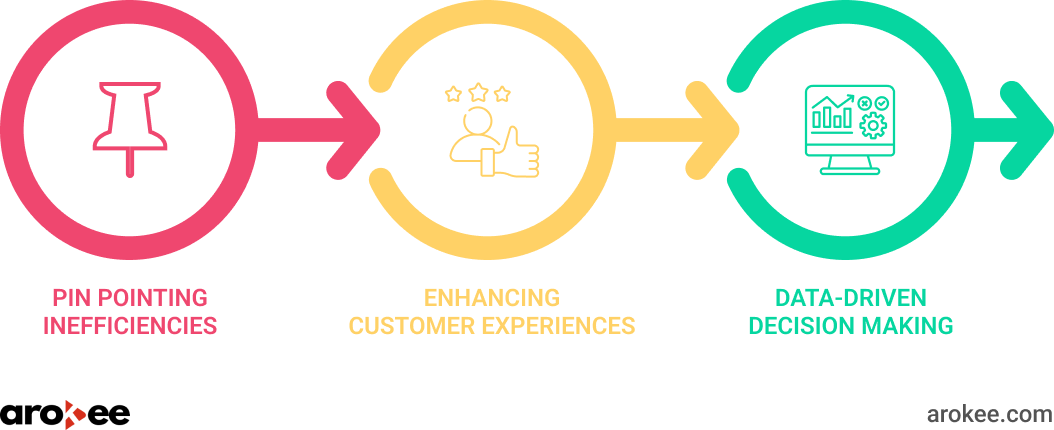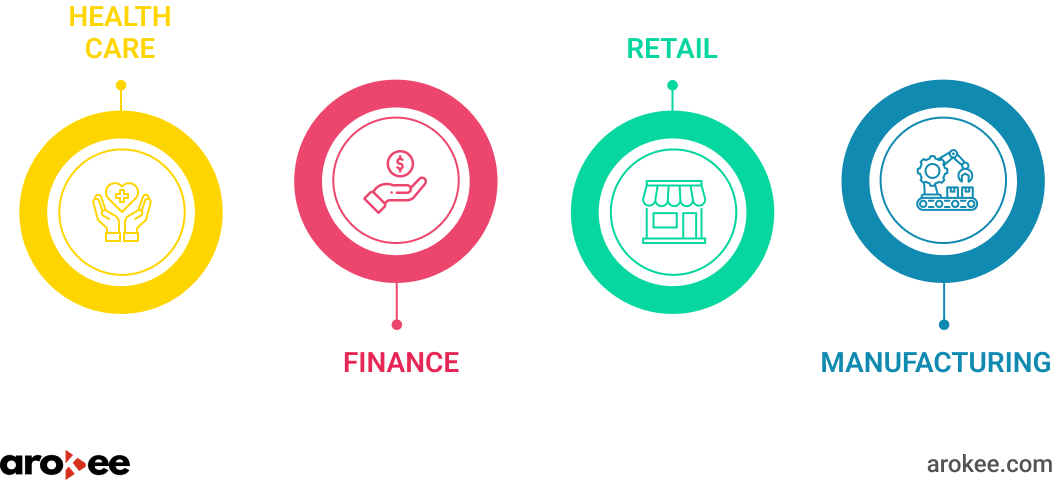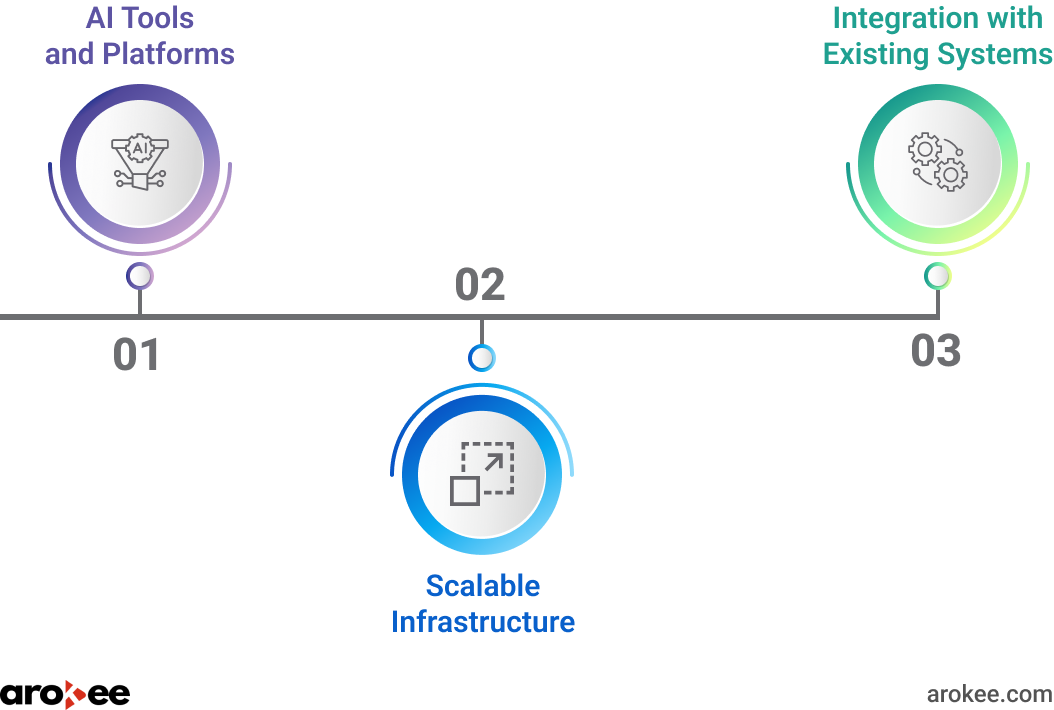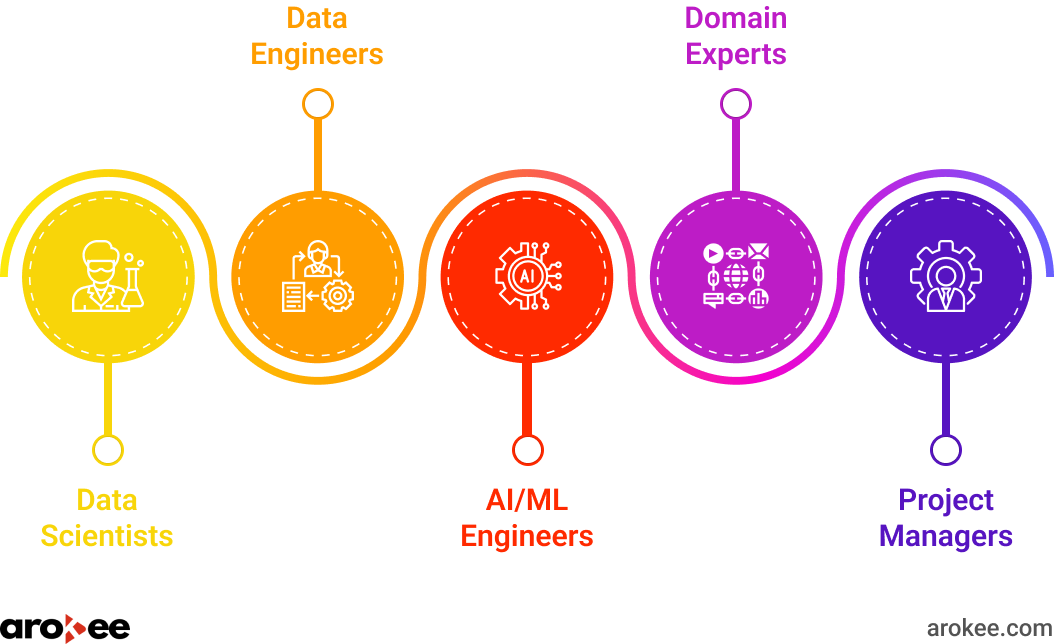Table of Content
- Beyond the Hype, into Actionable AI
- The Business Case for AI
- Crafting Your AI Strategy: A Roadmap to Success
- Building the AI Roadmap: A Blueprint for Action
- Data: The Fuel for Your AI Engine
- Technology and Infrastructure
- Building Your AI Dream Team
- Implementing AI Projects: An Iterative Approach
- Change Management and Adoption
- Monitoring and Evaluation
- Conclusion
Beyond the Hype, into Actionable AI
While AI’s ability to analyze colossal datasets, automate complex tasks, and revolutionize decision-making is widely acknowledged, its successful implementation demands more than just technological prowess. Businesses must craft a meticulously designed AI strategy that seamlessly aligns with their overarching goals and objectives.
In this comprehensive guide, we’ll delve beyond the hype, providing a clear roadmap for businesses to navigate the complexities of AI implementation. We’ll explore how to identify your organization’s unique needs, pinpoint suitable AI applications, and establish clear, measurable goals that drive tangible results. Whether you’re an AI novice or a seasoned practitioner, this guide will equip you with the knowledge and insights necessary to harness the full power of AI for your business.
The Business Case for AI: A Value-Driven Approach

Before embarking on your AI journey, it’s imperative to establish a solid business case for AI adoption. This involves a deep dive into your organization’s existing processes, identifying pain points and areas where AI can deliver substantial value.
- Pinpointing Inefficiencies: Analyze your operations to uncover bottlenecks, manual tasks, and areas where errors frequently occur. These are prime candidates for AI-powered automation, which can streamline workflows, reduce human error, and boost overall efficiency.
- Enhancing Customer Experiences: Explore how AI can personalize customer interactions, provide tailored recommendations, and offer 24/7 support through chatbots or virtual assistants. These enhancements can lead to increased customer satisfaction and loyalty.
- Data-Driven Decision Making: Identify areas where AI-powered data analytics can unlock valuable insights from your data. This could involve predictive modeling for sales forecasting, customer churn prediction, or risk assessment.
The potential benefits of AI are not merely theoretical. Businesses across various industries are already reaping the rewards of AI implementation:

- Healthcare: AI-driven diagnostics tools are accelerating the detection and treatment of diseases, while predictive models are aiding in disease outbreak prevention.
- Finance: AI-powered fraud detection systems are safeguarding financial institutions and consumers, while algorithmic trading is optimizing investment strategies.
- Manufacturing: AI is transforming production lines through predictive maintenance, quality control, and supply chain optimization.
- Retail: AI-powered recommendation engines, personalized marketing campaigns, and inventory management systems are enhancing the retail customer experience and driving sales.
By quantifying the potential impact of AI on your specific business goals, you can build a compelling case for investment and secure buy-in from stakeholders.
Crafting Your AI Strategy: A Roadmap to Success
Developing a successful AI strategy requires a systematic approach that aligns AI initiatives with your business objectives:
1. Strategic Alignment: Clearly define how AI can contribute to your overarching business goals. Whether it’s increasing market share, improving customer retention, or reducing costs, ensure that your AI projects are directly linked to these strategic objectives.
2. Capability Assessment: Conduct a thorough evaluation of your organization’s existing capabilities and resources. Assess your data infrastructure, technological tools, and human capital. Identify any gaps that need to be addressed to ensure a smooth AI implementation.
3. SMART Objectives: Set Specific, Measurable, Achievable, Relevant, and Time-bound (SMART) objectives for your AI initiatives. These objectives will serve as benchmarks for tracking progress and evaluating success. For example, your objective might be to reduce customer service response time by 20% within six months using an AI chatbot.
Building the AI Roadmap: A Blueprint for Action
With your strategic goals and objectives clearly defined, it’s time to create a detailed AI roadmap:
1. Key Projects Identification: Identify the specific AI projects that will deliver the most significant impact on your business goals. These projects should address the pain points you identified earlier and align with your strategic priorities.
2. Prioritization: Not all AI projects can be tackled simultaneously. Use a prioritization matrix to evaluate the potential impact and feasibility of each project. Focus on high-impact, low-complexity projects first, followed by more complex or less impactful initiatives.
3. Timelines and Milestones: Establish clear timelines and milestones for each AI project. Break down projects into smaller, manageable tasks, and set deadlines for each milestone. This will help you track progress and ensure that projects stay on schedule.
Data: The Fuel for Your AI Engine
A robust data strategy is fundamental to the success of any AI initiative. High-quality data is the fuel that powers AI models, and ensuring its integrity is paramount:
1. Data Quality and Governance: Implement data governance policies that establish clear ownership, standardized formats, and validation checks for all data used in AI projects. Regularly cleanse and update your data to maintain accuracy and completeness.
2. Data Collection and Management: Develop a comprehensive data collection strategy that gathers relevant data from diverse sources. Invest in data integration tools to consolidate data from different systems and create a centralized data repository.
3. Data Privacy and Security: Protect sensitive data with robust security measures, including encryption, access controls, and regular audits. Ensure compliance with data privacy regulations like GDPR and CCPA to maintain trust and avoid legal repercussions.
Technology and Infrastructure: Empowering Your AI Vision

Selecting the right AI tools and infrastructure is crucial for successful implementation:
1. AI Tools and Platforms: Choose AI platforms and tools that align with your specific needs and project goals. Consider factors like scalability, ease of use, and compatibility with your existing systems. Popular options include TensorFlow, PyTorch, and cloud-based platforms like AWS SageMaker and Google Cloud AI Platform.
2. Scalable Infrastructure: Invest in scalable infrastructure that can accommodate the growing demands of your AI projects. Cloud-based solutions offer flexibility and cost-effectiveness, allowing you to scale resources up or down as needed.
3. Integration with Existing Systems: Ensure seamless integration of AI solutions with your current IT infrastructure. Use APIs and middleware solutions to connect AI models with your existing systems and applications.
Building Your AI Dream Team

A successful AI implementation requires a multidisciplinary team with diverse skill sets:
- Data Scientists: These experts are responsible for building, training, and fine-tuning AI models. They possess strong analytical and statistical skills, as well as expertise in machine learning algorithms.
- Data Engineers: These professionals design and maintain the data infrastructure that supports AI initiatives. They ensure data is collected, processed, and stored efficiently.
- AI/ML Engineers: These specialists focus on deploying and scaling AI models in production environments. They optimize model performance, ensure reliability, and manage infrastructure.
- Domain Experts: These individuals possess in-depth knowledge of the business domain where AI is being applied. They provide valuable context and ensure that AI solutions address real-world problems effectively.
- Project Managers: These leaders oversee the entire AI project lifecycle, from planning and execution to monitoring and evaluation. They ensure projects stay on track, within budget, and deliver the desired outcomes.
Implementing AI Projects: An Iterative Approach
AI projects are best approached through an iterative development process:
1. Prototyping and Testing: Begin by developing prototypes of your AI solutions. These prototypes allow you to test concepts, gather feedback, and refine your approach based on real-world data and user interactions.
2. Iterative Development: Embrace an agile methodology that allows for continuous improvement. Regularly evaluate the performance of your AI models, gather feedback, and make necessary adjustments to optimize results.
3. Measuring Success: Establish clear metrics and key performance indicators (KPIs) to measure the success of your AI initiatives. Regularly track these metrics to assess progress and identify areas for further refinement.
Change Management and Adoption: Fostering a Culture of AI
Successful AI implementation goes beyond technology; it requires a cultural shift within your organization:
1. Preparing the Organization: Communicate the benefits and potential impacts of AI to all stakeholders. Leadership should champion the adoption of AI and emphasize its alignment with the company’s vision.
2. Training and Upskilling: Invest in training and upskilling programs to equip your workforce with the necessary skills to work alongside AI technologies. This can involve workshops, online courses, and mentorship programs.
3. Managing Resistance: Address concerns and fears about AI head-on. Encourage open communication and involve employees in the AI implementation process to foster buy-in and enthusiasm.
Monitoring and Evaluation: The Cycle of Continuous Improvement
The AI journey doesn’t end with implementation. Continuous monitoring and evaluation are essential for long-term success:
1. Metrics and KPIs: Regularly track your predefined metrics and KPIs to assess the performance of your AI initiatives. This will help you identify areas where the models are excelling and where they need improvement.
2. Regular Review: Conduct periodic reviews of your AI strategy and projects. Evaluate the outcomes, gather feedback, and make data-driven decisions to optimize your AI efforts.
3. Adaptability: The AI landscape is constantly evolving. Be prepared to adapt your strategy based on new technologies, changing business needs, and the insights gained from your ongoing evaluation.
Conclusion: Embrace the AI Revolution
In the age of AI, businesses that embrace this transformative technology stand to gain a significant competitive advantage. By developing a well-articulated AI strategy, building a capable team, prioritizing data integrity, and fostering a culture of innovation and adaptation, you can unlock the full potential of AI for your organization. Remember, AI is not just about technology; it’s about leveraging intelligent tools to drive business growth, enhance customer experiences, and shape a brighter future. Start your AI journey today and position your business at the forefront of the AI revolution.






